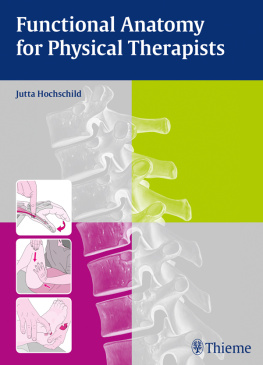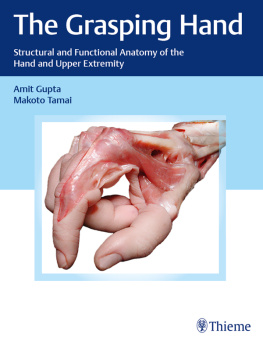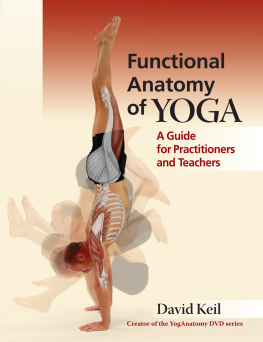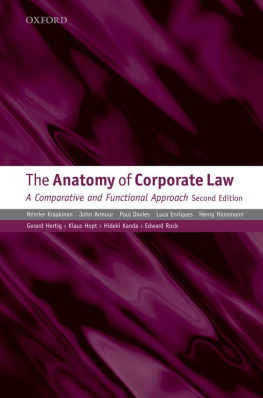Hochschild - Functional Anatomy for Physical Therapists
Here you can read online Hochschild - Functional Anatomy for Physical Therapists full text of the book (entire story) in english for free. Download pdf and epub, get meaning, cover and reviews about this ebook. year: 2016, publisher: Thieme Medical Pub, genre: Romance novel. Description of the work, (preface) as well as reviews are available. Best literature library LitArk.com created for fans of good reading and offers a wide selection of genres:
Romance novel
Science fiction
Adventure
Detective
Science
History
Home and family
Prose
Art
Politics
Computer
Non-fiction
Religion
Business
Children
Humor
Choose a favorite category and find really read worthwhile books. Enjoy immersion in the world of imagination, feel the emotions of the characters or learn something new for yourself, make an fascinating discovery.
- Book:Functional Anatomy for Physical Therapists
- Author:
- Publisher:Thieme Medical Pub
- Genre:
- Year:2016
- Rating:5 / 5
- Favourites:Add to favourites
- Your mark:
- 100
- 1
- 2
- 3
- 4
- 5
Functional Anatomy for Physical Therapists: summary, description and annotation
We offer to read an annotation, description, summary or preface (depends on what the author of the book "Functional Anatomy for Physical Therapists" wrote himself). If you haven't found the necessary information about the book — write in the comments, we will try to find it.
Functional Anatomy for Physical Therapists — read online for free the complete book (whole text) full work
Below is the text of the book, divided by pages. System saving the place of the last page read, allows you to conveniently read the book "Functional Anatomy for Physical Therapists" online for free, without having to search again every time where you left off. Put a bookmark, and you can go to the page where you finished reading at any time.
Font size:
Interval:
Bookmark:

Library of Congress Cataloging-in-Publication Data
Hochschild Jutta, author.
[Strukturen und Funktionen begreifen. English]
Functional anatomy for physical therapists/Jutta Hochschild.
p.; cm.
ISBN 978-3-13-176861-2 (alk. paper)
ISBN 978-3-13-176871-1 (eISBN)
I. Title.
[DNLM: 1. Physical Therapy Modalities. 2. Anatomy. 3. Physiological
Phenomena. WB 460]
QM 26
612-dc23
2015034186
This book is an authorized translation of the 2-volume 3rd German edition published and copyrighted 2005 and 2008 by Georg Thieme Verlag, Stuttgart. Title of the German edition: Strukturen und Funk-tionen begreifen: Funtionelle Anatomie: Therapierelevante Details T.p. verso.
Translator: Alan Wiser, MD, Ambler, PA, USA
Illustrator: Malgorzata & Piotr Gusta, Champigny sur Marne, France
1st Italian edition 2003
1st Japanese edition 2011
2016 Georg Thieme Verlag KG
Thieme Publishers Stuttgart
Rdigerstrasse 14, 70469 Stuttgart, Germany
+49 [0]711 8931 421,
Thieme Publishers New York
333 Seventh Avenue, New York, NY 10001, USA
+1-800-782-3488,
Thieme Publishers Delhi
A-12, Second Floor, Sector-2, Noida-201301
Uttar Pradesh, India
+91 120 45 566 00,
Thieme Publishers Rio, Thieme Publicaes Ltda.
Edifcio Rodolpho de Paoli, 25 andar
Av. Nilo Peanha, 50 Sala 2508
Rio de Janeiro 20020-906 Brasil
+55 21 3172 2297/+55 21 3172 1896
Cover design: Thieme Publishing Group
Typesetting by Druckhaus Gtz GmbH, Ludwigsburg, Germany
Printed in Germany by appl druck, Wemding
ISBN 978-3-13-176861-2 54321
Also available as an e-book:
eISBN 978-3-13-176871-1
Important note: Medicine is an ever-changing science undergoing continual development. Research and clinical experience are continually expanding our knowledge, in particular our knowledge of proper treatment and drug therapy. Insofar as this book mentions any dosage or application, readers may rest assured that the authors, editors, and publishers have made every effort to ensure that such references are in accordance with the state of knowledge at the time of production of the book.
Nevertheless, this does not involve, imply, or express any guarantee or responsibility on the part of the publishers in respect to any dosage instructions and forms of applications stated in the book. Every user is requested to examine carefully the manufacturers leaflets accompanying each drug and to check, if necessary in consultation with a physician or specialist, whether the dosage schedules mentioned therein or the contraindications stated by the manufacturers differ from the statements made in the present book. Such examination is particularly important with drugs that are either rarely used or have been newly released on the market. Every dosage schedule or every form of application used is entirely at the user's own risk and responsibility. The authors and publishers request every user to report to the publishers any discrepancies or inaccuracies noticed. If errors in this work are found after publication, errata will be posted at www.thieme.com on the product description page.
Some of the product names, patents, and registered designs referred to in this book are in fact registered trademarks or proprietary names even though specific reference to this fact is not always made in the text. Therefore, the appearance of a name without designation as proprietary is not to be construed as a representation by the publisher that it is in the public domain.
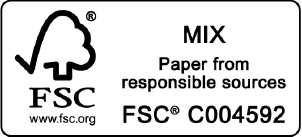
This book, including all parts thereof, is legally protected by copyright. Any use, exploitation, or commercialization outside the narrow limits set by copyright legislation, without the publisher's consent, is illegal and liable to prosecution. This applies in particular to photostat reproduction, copying, mimeographing, preparation of microfilms, and electronic data processing and storage.
Anatomy, with all its fascinating facets to investigate and teach, has been and continues to be my calling. To probe more deeply into the interconnections between structures and, through that, to clarify many functional problems that patients have never ceases to engage me.
My students have always had a great deal to learn, but it is important to me that they understand anatomy, not merely memorize it. I dedicate my book to them. Based on 25 years and approximately 7,000 hours teaching functional anatomythis book evolved from an instructional manual after many years of work.
My book should not and cannot replace the classical anatomy texts. Rather, it is a supplement to them. Thus, I delve thoroughly into joint surfaces and the formation of joints, while only briefly describing the bones. While I have assumed a background knowledge of muscle origins and insertions, I feel it is important to describe the functional aspects of the muscles.
Palpation of the various structures makes up a large portion of the book. It remains an important component of examination and treatment in physical therapy.
I hope that my references to pathology and the practical tips are useful for all my colleagues in everyday practice.
I especially wish to thank the illustrator, Piotr Gusta and his wife, who immersed themselves deeply in their work. The superb, detailed figures found in this book are the result.
I would like to thank Dr. Alan Wiser for his excellent translation. I would also like to extend thanks to Angelika-Marie Findgott and Gabriele Kuhn-Giovannini for their excellent support, and to all the other associates at Thieme Publishers who participated in the production of this book.
I also thank my colleagues at the School of Physical Therapy at the University Hospital Frankfurt. They have always assisted me in gathering important data.
Jutta Hochschild
Chapter 1
Viewed laterally, the spinal column develops from being totally kyphotic in the early embryonic phase to the normally curved spine with two areas of kyphosis and two areas of lordosis within the first 7 years of life.
The following events occur during growth: Cervical lordosis develops when the infant attempts to lift its head from the prone position while trying to move on all fours. The lordosis in the lumbar spine develops during the process of standing upright. Because of the lack of flexibility of the hip flexors, any extension of the hip joints causes an inclination of the pelvis, which further accentuates the lordosis of the lumbar spine. This process is not complete until near the end of the 6th year of life.
The ideal spinal curvature has been determined with the help of computer analysis. In the erect position, the plumb line cuts through the anterior tubercle of the atlas (a in ), the sixth cervical vertebra (b), the ninth thoracic vertebra (c), the third sacral vertebra, (d) and the tip of the coccyx (e).
Practical Tip
Assessment of the statics of the spine is an important part of the physical therapy record. Among other things, the characteristics of the curvature in the sagittal plane are recorded. Deviations from the norm are the hollow round back with increased lumbar lordosis and thoracic kyphosis, and the flat back with attenuation of the physiologic curvatures.
Font size:
Interval:
Bookmark:
Similar books «Functional Anatomy for Physical Therapists»
Look at similar books to Functional Anatomy for Physical Therapists. We have selected literature similar in name and meaning in the hope of providing readers with more options to find new, interesting, not yet read works.
Discussion, reviews of the book Functional Anatomy for Physical Therapists and just readers' own opinions. Leave your comments, write what you think about the work, its meaning or the main characters. Specify what exactly you liked and what you didn't like, and why you think so.

